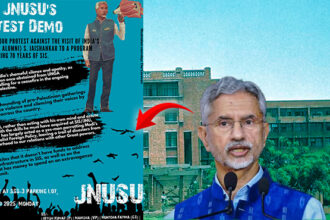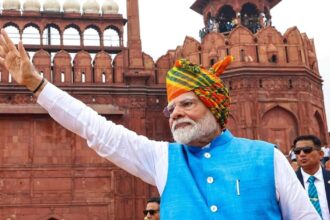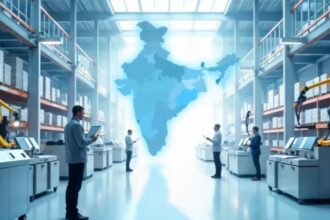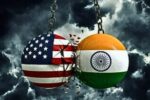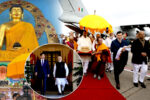Earlier this week, an Indian Air Force aircraft from India landed in Russia’s Kalmykia Republic with sacred Relics of Lord Buddha. The Relics have been accompanied by Uttar Pradesh deputy chief minister Shri Keshav Prasad Maurya, monks, and officials. It is another instance of PM Modi-led government’s efforts for strengthening cultural ties between India and a land of shared heritage. The Republic of Kalmykia — the only Buddhist region in Europe – has become a recipient of pilgrimage from an Indic view. India will display Buddhist art and manuscripts and related traditions that highlight spiritual heritage – in an extension of darshan, devotion and exposition underlining spiritual heritage.
During times when the world defines India’s relationship with Russia in the context of crude oil, power, or in Russia’s war against Ukraine, this development in spiritual ties between India and Russia, with the Republic of Kalmykia in focus, has drawn attention to the massive power of spiritual and cultural ties. It has compelled a new outlook to cultural connections. Establishing a long-lasting connection with Russia, particularly the Buddhist community of Kalmykia, India has explored a deep-rooted spiritual connection by organising an exposition of the Holy Relics of Lord Buddha – formally enshrined in Kalmykia for 8 days till October 18, 2025.
The relics will be enshrined at a Buddhist monastery in Elista. According to reports, the Geden Sheddup Choikorling Monastery, also called the “Golden Abode of Shakyamuni Buddha,” is a Tibetan Buddhist centre of importance. The 19th Kushok Bakula Rinpoche (May 21, 1917 – November 4, 2003) — a revered Buddhist monk from Ladakh, a diplomat, known for his efforts in reviving Buddhism in Mongolia and Russia, established the connections of Russia and Mongolia with the community of Tibetans living in exile in India. Decades later, Russia and Mongolia have come up in the Modi-government’s focus in the reaffirming of Buddhism-based cultural ties. This can also be seen as a tribute to the efforts, work, vision and legacy of the 19th Kushok Bakula Rinpoche.
In an event of profound spiritual and cultural significance, the exposition has been put together by the Ministry of Culture in collaboration with the International Buddhist Confederation, the National Museum, and the Indira Gandhi National Centre for the Arts (IGNCA). Dedicated to the veneration of the Budddha, three unique exhibitions have been opened by Keshav Prasad Maurya. They have been offered in the presence of H.E. Mr. Batu Khasikov, Head of the Republic of Kalmykia.
Among the exhibitions opened by Maurya is: “Sacred Legacy of the Shakyas: Excavation and Exposition of Buddha’s Relics”. According to a government document, “it traces the remarkable journey of the Buddha’s relics from their ancient enshrinement to their rediscovery. It opens with a map locating Piprahwa, identified with the ancient city of Kapilavastu, the capital of the Shakya clan. The panels guide visitors through the sacred geography in India of the Buddha’s final days and the regions that hold the legacy of his timeless teachings.”
Building the immersive visual exposition
During his visit, Maurya visited a park dedicated to Mata Green Tara. India will be contributing full assistance to developing the park as a major religious tourist destination, including the provision of building materials and a statue of Lord Buddha, government documents state. The Republic of Kalmykia is associated with the Great Silk Way and its steppes are steeped in ancient history. Maurya’s visit will be marked by the presentation of the Holy ‘Kanjur’ (sacred texts). These are Mongolian religious texts. According to a document, a set of 108-volumes were originally translated from the Tibetan language. Nine Buddhist universities and institutions will receive the ‘Kanjur’. And the aspect of the offering of the Holy ‘Kanjur’ is where a triangular pattern of sharing Buddhist heritage emerges between three powers in the region – India, Russia, and Mongolia.
The immersive engagement also presents ‘Bodhicitta’- Treasures of Buddhist Art — an exhibition put together by the National Museum of India and the National Mission for Manuscripts.
As the land of Buddha, as custodian of a rich civilisational past, and as Vishwa Mitra in the continuously evolving position in the global shifts, India carries the responsibility and power of initiating journeys for Dharma and dharmic fervour. India bears the gifts of a timeless heritage, endowed upon this sacred land, by the life and teachings of Lord Buddha. It shares this heritage with other nations that have embraced the teachings of Buddha over centuries.
Darshan, ‘dharma’, devotion, diplomacy
Darshan – the glimpse of the sacred – and the spiritual connection established between the sacred and the devotee; and devotion, are at the core of PM Modi’s efforts in sharing shared heritage with Russia, Mongolia, nations in South East Asia, Nepal, and other nations. With that, PM Modi has made possible a reset of the idea of pilgrimage in Asia. The sacred sets on a journey to the devotee, the sacred brings different nations of devotees of the Buddha together, the culmination of pilgrims happens as the pilgrimage advances, and the sacred returns to the land of Buddha – after the journey in pilgrimage – for a continuing journey.
Under the leadership of PM Modi and the convergence of spirituality, cultural partnership, diplomacy and soft power, the journey of Lord Buddha’s relics, from Bharat to other lands of shared heritage, is leading to a rediscovery of pilgrimage. The culmination of the historic ceremonious ‘yatras’ of the sacred relics of Lord Buddha, is leading to stronger ties between India and countries of shared heritage. India’s journey in the role of “Vishwa Mitra” is incomplete without exploring the potentials of spiritual diplomacy and strengthening regional ties through the celebration of heritage, civilisational values, and cultural connections.
The acknowledgement of the rich spiritual heritage of India as well as the nation of shared heritage that hosts the journey of the sacred relics of Lord Buddha, helps in reaffirming shared values for future discourse in a play of empathy, understanding, compassion and partnership. The sacred relics that are housed for protection at different museums or sites in India are taken out for expositions in the different nations, unlocking the immense opportunities for building reconnections on the foundations of dharma, devotion, spirituality, preservation, civilisations, and fraternity.
In continuation with cultural exchanges with Thailand, PM Narendra Modi announced this year that India would repeat the loaning of sacred relics of the Buddha to Thailand. “I am happy to announce that the holy relics of Lord Buddha, found in Gujarat’s Aravalli in 1960, will also be sent to Thailand for darshan,” he said. Noticeable is how sacred relics, that are Lord Buddha’s heritage, are not being viewed as merely artefacts discovered. They are being upheld and preserved as sacred in nature and hence being shared for ‘darshan’ and devotion, for devotees in other lands — while being archaeological treasures.
The pilgrimage, preservation and vital breakthroughs
In the past, holy Relics of the Buddha have been taken to Mongolia, Thailand, and Vietnam in the past. In June this year, a journey of Lord Buddha’s Relics to Vietnam saw an unprecedented pilgrimage unfolding over a month. The relics reportedly drew nearly 17.8 million devotees. The sacred relics were sent to Vietnam by the Modi-led government in collaboration with the International Buddhist Confederation (IBC). As the journey of relics progressed from one province to another, the pilgrimage drew millions of devotees, who converged at the different pagodas and centres of devotion in processions, marking their own profound tradition of prayers, meditative sessions, chanting, and Dharma teachings.
In 2022, the Piprahwa relics at the National Museum were taken to Mongolia. In 2024, the sacred relics of the Buddha and his two disciples, at Sanchi, were taken on a journey to Thailand. The holy relics that embarked on a journey to Vietnam in June this year were from Sarnath. The sacred relics that have been taken on an exposition to Russia, are enshrined at the National Museum in New Delhi. According to government documents: “The holy relics being taken to Kalmykia belong to this same family of relics based in the National Museum.”
Under the Modi-government, the larger work of preservation of culture and upholding Buddhist heritage, India’s efforts hold value for the Buddhist family across the globe. Among the steps is the repatriation of more than 600 antiquities during Modi-rule. Many of these antiquities are related to Buddhism and legacy.
Repatriation of India’s heritage and sculptural wealth has been Modi’s government mission. In a major breakthrough this year, the Indian government was successful in the repatriation of ancient gem relics linked to the Buddha’s remains. A note from the PMO said that Piprahwa relics were discovered in 1898, but they were taken from India during Colonial rule. When the jewels appeared in Sotheby’s auction, India dived into the work to rescue and secure them. Two months before this breakthrough, auction house Sotheby’s had to halt and postpone their sale of these sacred artefacts in Hong Kong because the culture ministry, Government of India, said that it will take legal action in Indian and Hong Kong courts “for violations of cultural heritage laws”. The gems were rescued in a public-private partnership between the Indian government and Godrej Industries Group, reports say.
Celebrating the return of the sacred Piprahwa relics of Bhagwan Buddha to India after 127 long years, PM Modi wrote: “A joyous day for our cultural heritage! It would make every Indian proud that the sacred Piprahwa relics of Bhagwan Buddha have come home after 127 long years. These sacred relics highlight India’s close association with Bhagwan Buddha and his noble teachings. It also illustrates our commitment to preserving and protecting different aspects of our glorious culture. #VikasBhiVirasatBhi.”
Development and heritage do not stand separated in PM Modi’s work and vision. He extends it to diplomacy and his cultural outreach to other lands.
The creative path to strategic partnership
Under PM Modi, India has not only identified the need to secure Relics of sacred and reverential value, but has creatively-altered the course of their veneration, celebration, protection and custodianship. In scripting journeys of the sacred relics of the Buddha to nations and regions venerating and celebrating shared heritage, India has given a message that spiritual heritage is not meant for commodification. It is the right governance that examines these elements of sacred value as not mere artefacts of archeological and historic importance.
As custodian, India makes a spiritual offering to the Buddhist world — in different regions — in the form of journeys the relics embark upon to the devotees and devotion. India’s work towards gathering the blessings of Buddhist devotees in the lands of shared heritage, reflects PM Modi’s own immersive understanding of India’s importance as a builder of immersive engagement. It underlines India’s generosity as a land of pilgrimage, setting a series of journeys in pilgrimage – devotion and dharma as central to spiritual ties – in foreign lands.
Simultaneously, during the same week, PM Modi has initiated a new chapter with a “spiritual sibling” nation. The President of Mongolia was on a visit to India after six years this week. Both nations celebrate 70 years of diplomatic ties and 10 years of Strategic Partnership, however, the bond becoming thicker is that defined by Buddhism, Buddhist culture, civilizational heritage and people to people ties. In his joint statement PM Modi underlined sharing of the age-old bond of Buddhism. He said: “this is why we are also called spiritual siblings.” Under PM Modi India is working to strengthen these ties. PM Modi said that next year, the holy relics of two great disciples of Lord Buddha – Sariputra and Maudgalyayana – will be sent from India to Mongolia.
PM Modi informed that India will send Sanskrit teachers to Gandan Monastery to support in-depth study of Buddhist texts and continue the ancient tradition of knowledge. “We have decided to soon launch a project to digitize one million ancient manuscripts. Nalanda University has played a vital role in Buddhism in Mongolia, and today we have agreed to strengthen this historic connection by linking Nalanda with Gandan Monastery,” PM Modi said.
While India’s strategic partnership with Mongolia has become stronger during the last 10 years, the role of “spiritual siblings” will guide futuristic steps such as the signing of MoU between the Ladakh Autonomous Hill Development Council and Mongolia’s Arkhangai Province and becoming partners in development with a nation that, in PM Modi’s words, India doesn’t share a border with, but has always considered a close neighbour. This is redefining spiritual connections in a geography of deep strategic importance.
India making the offering of the Holy Kanjur — sacred scriptures – is common to the bold steps in strengthening ties with Russia and Mongolia.
In peace, in scripting and carving of peace through power, in asserting peace through acts of defence to protect India, the NDA governments — under PM Modi and former PM Atal Bihari Vajpayee – have chosen the sacred day of Buddh Poornima – Lord Buddha’s birthday – for sending a message of peace through nuclear and military power. PM Modi has even mentioned at the United Nations that the world’s solution lies in Buddha, and that India offers the world not yuddh (war), but Buddha. PM Modi’s historic address during Operation Sindoor, too, took place on Buddh Poornima, where he mentioned that Lord Buddha has shown us the path of peace, and the path of peace also goes through power.
His reference to peace through power includes the celebration of the legacy of Odisha and Samrat Ashoka. “The great land of Odisha, where you are gathered today, is a reflection of India’s heritage. When there was a time in the world to expand the empire on the strength of the sword, our emperor Ashoka chose the path of peace here. This is the strength of our heritage with the inspiration of which India is able to tell the world today that the future is not in Yuddh, it is Buddha.” The reassertion of peace through Buddha travels to different destinations with PM Modi – in India and outside.
Vision of the Varanasi MP, the eye for regional interconnections
PM Modi credits his birth in Vadnagar, which is known for being a centre for Buddhism, for his bond with Buddhism. Among India’s steps in honouring the great heritage-legacy of Lord Buddha is the recognition of the classical heritage associated with it. Under the Modi-government, Pali was recognised as a classical language and great efforts are being poured for its exploration, preservation, documentation, and sharing of its heritage with shared cultures.
As Member of Parliament from Varanasi — home to Sarnath, PM Modi is cementing India’s diplomatic and strategic ties on the foundation of cultural and spiritual ties nourished by Buddhist heritage, with not only Mongolia, and Russia, but also Nepal. Mongolia does not share a border with India. PM Modi has viewed Mongolia as a “spiritual sibling of India” and a neighbour of profound importance. Aspects related to Mongolia’s geographical presence — particularly its location between China and Russia, make it strategically important to India.
India will begin efforts for enhancing capacity-building for Mongolia’s border security forces, the signing of 10 MoUs that cover a vast expanse of areas, and a focussed initiation of ties between Ladakh and the Arkhangai province of Mongolia. It is an indication that warmth of cultural ties based on spiritual heritage will nurture strengths between the two nations in present and future.
India’s ties with Nepal, in the global-popular perception, are unflinchingly-eternal owing to Hinduism, Hindu roots, people to people connection strengthened by Hindu traditions, festivals, rituals and worship. However, under PM Modi’s leadership, India has made stronger efforts to celebrate Lord Buddha’s birthplace of Lumbini, with the development of the Buddhist circuit, under which, places related to Lord Buddha in India and Nepal, are being developed as a Buddhist circuit. They are being strung together in a circuitous series of pilgrimage, darshan and devotion. Work on the infrastructure supporting the circuit in Bodh Gaya, Kapilvastu, Sanchi, establishing Centre for Buddhist Culture and Heritage, and an international airport at Kushinagar, shows the Modi-government’s inclination for exploring ties defined by Buddhism and shared Buddhist-heritage. Pilgrimage and sacred paths are being constantly redefined by Modi-led India, and this will add steel to the Vishwa Mitra’s resolve for peace through power.




